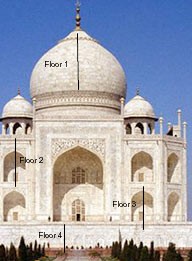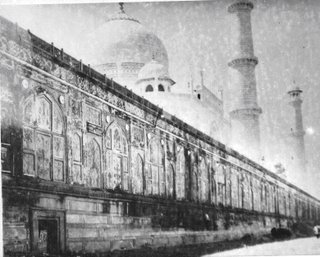Napoleon Bonaparte.
After months of brewing, my mind is at last ready to write about the monument the sight of which had me speechless. The white marble edifice, the world knows as the Taj Mahal, grave of Mumtaz Mahal Mughal Emperor Shah Jehan’ s beloved wife (this also is disputed by some), was never shorn of controversies. The latest one takes the cake however: Taj Mahal was ‘Tejo Mahalya’, an ancient Shiva temple!
One professor P.N. Oak has written a book (Taj Mahal: The True Story) elaborating on how he feels the world has been taken for a ride by hiding the true facts regarding the structure.
I admit that having failed to procure a copy; I am compelled to comment, though obliquely, on its contents. However, I only attempt to present my point of view regarding the controversy.
So, some believe that it was a sacred place…a temple palace wherein the idol worshipped was that of Lord Shiva.
Since I have not conducted any research that many others seemed to have been a part of, let me take the statement at its face value. The point is that it was a temple. Might have been…no intention of disputing it. Indian history is after all pregnant with facts that the Mughal rulers, for reasons known and fancied by them, destroyed many Hindu temples and constructed structures suiting their religious taste. So, it was a temple. Does that stop it from being a grave that it is? Does it prove that the marble structure was not caused to be built by Shah Jehan? I think not. All that perhaps can be assumed or logically deduced is that this one also, like many others, was built over the remains of a temple. Also that perhaps the Emperor was no exception when it came to religious intolerance.
It is said that in Badshahnama, Shah Jahan’s court chronicle, there is a mention that an ‘exceptionally beautiful grand mansion’ in Agra belonging to Jai Singh was taken from him for the late Empress’s burial.
This could also be true. But how can anyone shut its eyes to the architecture of the Taj that is primarily and essentially Islamic? Only a keen eye and some fascination for such buildings does one require to understand something as basic as that. Again, the point is that this alleged mansion could have been razed by the Mughals to erect a new one. The present edifice still remains what it is popular as…Mumtaz Mahal’s resting place built by Shah Jehan. Period.

Picture of Taj showing four floors
Taj Mahal is claimed to be a seven storeyed structure. (see pic). It is said that there is a gap of 83 ft between the outer dome and the inner dome ceiling which makes the first storey. Then we have storey 2, which cannot be accessed by the public. In any case, I was not permitted to go upstairs when I visited the monument in 2004. Storey 3 consists of the counterfeit graves of the royals open for public viewing. The fourth one, barred by an iron grill, contains the true cenotaphs. A peek below is all that is permitted to the public. The 5th and 6th storey are made of red sandstone that can be seen from the rear (river side). It is claimed that they contain several rooms. The last one is below the river level, serving as a basement for the monument. Carbon dating is claimed to have been carried out on one of these sandstone structures and the result reveals it to be older than the times during which Shah Jehan ruled/lived.

